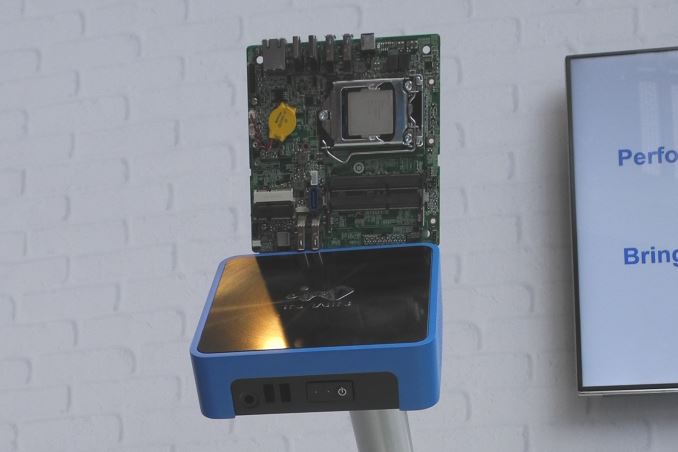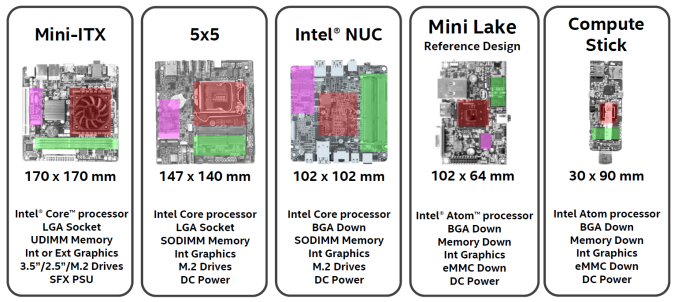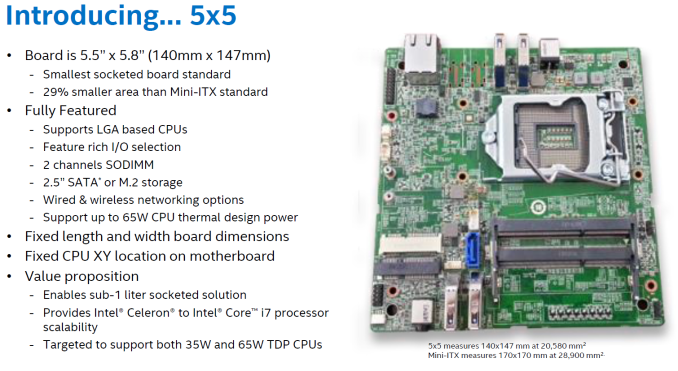Intel Launches New Socketed 5x5 mini-PC Motherboards
by Ganesh T S on August 24, 2015 4:35 AM EST- Posted in
- Trade Shows
- Systems
- Intel
- Motherboards
- Mini-PC
- IDF 2015
- 5x5

Over the last couple of years, the ultra-compact form factor (UCFF) has emerged as one of the bright spots in the troubled PC market. Kickstarted by Intel's NUC (Next Unit of Computing) designs, it has been successfully cloned by other vendors such as GIGABYTE (BRIX), Zotac (C-series nano) and ASRock (Beebox). With platform performance increasing every generation, and performance requirements getting tempered by the rise of the not-so-powerful smartphones and tablets, Intel could pack a heavy punch with their 102x102mm NUC motherboards.
Atom-based units (using Bay Trail) could provide very good performance for most users. Intel tried to shrink the PC even further by releasing a Compute Stick based on the Bay Trail Atom Z series SoCs earlier this year. ECS, with their LIVA designs, has adopted the Mini Lake reference design for their UCFF PCs. All of these UCFF PCs come with BGA CPUs / SoCs. The configurability aspect is minimal from an end-user's perspective. Looking at the mini-ITX form factor immediately leads us to a hole in the mini-PC lineup between it and the NUC.
At IDF last week, Intel quietly launched the new 5x5 motherboard form factor. Coming in at 147x140mm, it is closer to the NUC in the fact that it can operate directly off DC power and takes SODIMM memory. Approaching from the mini-ITX side gives us the LGA socket for a Core processor. Unfortunately, at this size, we have to make do without the full length PCIe slot.
Intel suggests that solutions using the 5x5 boards could come in with a 39mm height for a volume of 0.89L (when using M.2 drives and a heat sink suitable for 35W TDP CPUs). 65W TDP CPUs and 2.5" drive support would obviously increase the height requirements.
Many usage areas which required custom-sized embedded boards (such as digital signage / point of sale terminals / kiosks etc.) have now opened up for the PC, thanks to the NUC and other similar form factors that were introduced over the last year or so. The new 5x5 form factor ensures that a mini-PC is available for every size and performance requirement. As of now, it looks like In-Win has a chassis design ready for the new form factor. We are awaiting more information on the board(s) and availability details.












44 Comments
View All Comments
alaricljs - Monday, August 24, 2015 - link
Please note that bernstein said *thin* mini-ITX. These have x1 or x4 slots and never an x16. I was planning a thin mini-itx "luggable" to replace my laptop. Honestly the only reason to go with this new 5x5 for that would be more room to work with as a a 15" LCD footprint gives plenty of space for the mobo, Intel's off the side cooler, batteries and 2.5" drives.nightbringer57 - Monday, August 24, 2015 - link
Indeed, I missed the thin. My bad.MonkeyPaw - Monday, August 24, 2015 - link
Also, that slot was handy for adding a TV tuner for your HTPC. I've been using a mITX board in this way for years.Mobile-Dom - Monday, August 24, 2015 - link
interestingly, so in theory (whether useful or not) you could put the broadwell i7 (5775c?) inside one of these and have a not terrible gaming performance[-Stash-] - Monday, August 24, 2015 - link
I disagree. You would have decent general/office computing, but, due to the lack of PCIe slot and therefore discreet graphics card, the gaming would be very sub par for anything but the most basic of games (or old ones).You *could* play games, but you would have to run them very low resolution and very low detail – even something as undemanding as League of Legends would have to be put in fugly mode to get the desired frame rate.
Gigaplex - Monday, August 24, 2015 - link
Except the GPU on the Broadwell i7 is actually fairly potent.Flunk - Monday, August 24, 2015 - link
In Intel's dreams.ddriver - Monday, August 24, 2015 - link
A "potent" GPU - what does that mean? Does it have anything to do with procreation and begetting tiny infant GPUs? That must be it, because in the context of gaming hardware it is entirely "impotent" by contemporary standards. How if you play 10 year old games in VGA resolution, it might do the trick...Klimax - Tuesday, August 25, 2015 - link
YOu two should check out reviews about Iris Pro in Broadwell. Are you in for a surprise...V900 - Monday, August 24, 2015 - link
Have you read any reviews of Intels integrated graphics or high end CPUs at all since 2012?You should read up, cause a lot has changed since Sandy/Ivy Bridge.
The Iris Pro GPU in Broadwell is 50% faster than the fastest GPU in AMDs A10 APUs.
It handles GTA5 with no problems, and gets around 90FPS in Bioshock Infinite in Full HD. Over 120 FPS in Halflife Full HD.
It's no GT980, but it's right around a GT750 or GT560 in performance, and that's plenty for quite a few of us.